Abstract
Currently, worldwide attention to clean energy and sustainable energy has been expedited because of its many environmental benefits. In fact, wind and solar energies play a prime role in decarbonizing the energy market. However, finding the most suitable locations for wind/solar power plants is difficult because of the non-homogeneous distribution of these sources. This paper presents a novel method for selecting the optimal locations for wind and solar farms by mapping the space of the decision criteria to the site score. In addition, the multiple linear regression model was used, with the help of the combination of GIS and AHP methods, to model the siting of wind and solar power plants. The site scoring method used in this study is reliable and globally evaluated; therefore, the scores are accurate and effective. To reveal the ability of the proposed method, two study areas were investigated and researched. The results achieved based on the introduced method showed that, in case study 1, areas with an area of about 9, 4 and 7 km2 are suitable for the construction of wind, solar and wind/solar power plants, respectively. This paper also used fourteen existing wind/solar, wind and solar farms from five continents around the world. The results showed that the suggested model acts the same as the real data. In addition to the interest these results hold for the development of renewable energy in the study area, this novel approach may be applied elsewhere to select optimum sites for wind, solar, and combined wind and solar farms.
1. Introduction
Energy has been considered as the driving force of economic growth worldwide because of the rapid increase in the global population and industrialization [1]. In fact, insufficient fossil fuel and its impact on carbon emissions and global warming have influenced the harvesting of energy and alternative eco-friendly resources in recent years [2]. However, these alternative resources should be sustainable. Considerable potential lies in the development of renewable technologies, as these are free and widely available [3]. Towards the end of 2021, 365.9 billion USD was invested in renewable energy harvesting, and renewable energy accounted for 17% of the global energy consumption [4]. Wind and solar are estimated to be the most widely used renewable energy sources (RES). There is a particular advantage to the use of wind energy systems, as they convert the kinetic energy of air particles into a source of energy that is flexible and controllable [5]. For example, in 2020, global wind power generation reached 845 GW with the addition of 102 GW [6]. The increase in energy production causd by wind energy has encouraged researchers to more accurately assess wind power plants [7].
Solar radiation is abundantly available for heating and electricity generation, both indirectly and directly (photovoltaic) [8]. The photovoltaic energy capacity reached 942 GW following the addition of 175 GW from India, China, Japan, Germany, and the USA in the same year, making it the most popular RES in 2021 [4]. According to the European photovoltaic industry association, solar energy could supply from 10 to 15% of Europe’s electricity demand by 2030 [9].
Despite these benefits, RES is not distributed evenly across the planet. Each geographical region has its own economic, social, and environmental characteristics and constraints; thus, selecting an appropriate location to construct a renewable energy power plant is crucial [10]. Therefore, several factors, such as technical, economic, social, and environmental factors, should be considered when selecting a suitable location to construct a wind/solar power plant [11]. To tackle these challenges, a global site-selection model is proposed for wind and solar power plants in this paper, which does not have the limitations of previous studies.
The rest of this paper is arranged as follows: Section 2 assesses the literature review by investigating the approaches that were employed in previous research studies to solve the wind/solar power site-selection issues. Section 3 studies linear regression and explains how this method can be used to estimate the relationship between inputs and outputs. Section 4 focuses on the design of the proposed model and describes all steps that must be taken to design the site-selection model. This section discusses linear regression and AHP methods and related criteria. Site-selection equations and a verification of this model are provided in Section 5. A sampling of the case study with the help of GIS is introduced in the sixth section. In the rest of this section, we discuss the results of the present study. At the end of Section 6, the best locations to construct the power plants in two different case studies are provided. Finally, the vital results are outlined in Section 7 (conclusions).
2. Literature Review
2.1. Overview of Common Method in Site Selection
Renewable power plant site-selection was previously studied using traditional procedures and analytical methods [12,13,14,15]. Pennell et al. (1980) first introduced the effective criteria for selecting the ideal site for wind turbines and then, based on the experiences of experts, they recommended a method for the process of optimal site selection. Their results were not strong enough because they were based on probabilistic opinions [12]. Calzonetti and Eckert considered the process of location as necessary to increase efficiency in energy facilities. Their results showed that selecting the optimal location can have a strong impact on the efficiency of power plants. They defined the site-selection problem by considering various factors that have a significant effect on increasing efficiency [13]. In addition, Solomon and Heinz studied multi-objective decision rules (MODR) to select suitable sites for power plant construction in 1984 [15]. The site-screening methods used to find a power plant location were applied when bounding the decision space, multi-objective and goal programming decision rules used in this study [16,17].
After the evolution of the Geographic Information System (GIS) technology, this was used for site-selection issues [18,19,20,21,22]. In 2001, Baban and Perry studied wind site selection in the UK by considering several criteria and forms of GIS technology. First, some criteria were identified as crucial factors. Then, each criteria layer was evaluated between 0 and 10, where 0 and 10 showed the best and worst locations for power plant construction, respectively. Finally, the proper sites overlapped the previously evaluated layers through statistical methods and logical operators in GIS [18]. Amador and Dominguez used GIS to analyze technical and economic parameters to choose the most useful technology for rural electrification. They attempted to improve rural electrification by defining an index called levelling electric cost (LEC) for different technologies in GIS [23]. Carrio’n et al. used GIS to rank solar sites considering the legal rules and environmental criteria. The study area in this research was Andalusia in the south of Spain, and the results showed that 164,495.37 hectares of land are suitable for the construction of solar facilities and, by using this power plant, 38,693 of energy can be produced annually [24]. Mousavi et al. proposed an innovative method to solve the problems of electrification and potable water supply in villages that are far from cities. They investigated the study area with the help of GIS to provide the best scenario for the construction of a hybrid power plant [25].
After introducing multi-criteria decision-making (MCDM) methods to this field, each layer was weighted using the Analytic Hierarchy Process (AHP) and the Analytic Network Process (ANP). Subsequently, the calculated weights were applied to the layer in GIS [23,24,25,26,27,28,29,30]. In 2007, Bennui et al. studied some regions of Thailand to select suitable wind sites by weighting all data layers through AHP and applying them to the layers in GIS [23]. Janke (2010) proposed a hybrid method using MCDM and GIS to find locations with a high wind-power density to harvest optimal wind energy. In this article, the Colorado region was investigated, and the results showed that the north of this region has ideal conditions for installing wind turbines. This study also illustrated that high-altitude areas are of higher quality for wind farm investment [31]. Tegou et al. (2010) identified the best suitable location for installing wind turbines on the Greek island of Lesvos by combining the GIS and AHP methods. The authors claimed that the criterion of distance from the residential area is vital for the construction of wind-power plants because the authors believe that the shadow of wind turbine blades causes visual disturbances and recommended that wind farms be built far from residential areas [32]. Asadi et al. (2010) ranked wind sites in Iran by considering turbulence intensity (TI). Their research showed that TI can reduce the WPD and life of wind turbines. In this study, first, without considering the TI, the wind sites were ranked using the AHP method, and in the next step, the TI was considered as a technical criterion in the ranking process. The results showed that, when considering the TI, the ranking of the sites has changed significantly. In this study, the importance of WPD in relation to TI was identified as ranging from 1 to 5 [2]. Merrouni et al. [24] employed GIS to show how much PV capacity could be installed in the eastern region of Morocco. For this purpose, they considered distance from the power grid, roads, protected areas, land cover, land slope, and solar irradiation as criteria. The results showed that solar irradiation in this area, with an average of 1732 kWh/m2, was high. Additionally, over 74 percent of this area was suitable for the installation of a PV solar power plant. This area was equal to 44,863 km2 of 59,514 km2 [33]. In recent years, other MCDM methods such as the Electre, Topsis, Vikor, Oreste and Saw have been used as prioritizing options and weighting criteria [34,35,36,37,38,39,40,41]. For example, in 2014, Jun et al. conducted a site selection for wind/solar power plants using the Electre II method, in which the sites were ranked from the best to the worst [39].
Recently, site-selection processes were established by machine learning methods [42,43,44,45,46,47]. For instance, Shaheen and Zeb Khan studied wind-energy site selection, offering a data-mining framework and principal component analysis (PCA) [42]. This has been used for the dimensionality reduction of larger datasets for analyzing and modelling to predict a suitable site [42]. However, machine learning and data mining methods for site selection are in the primary stages and require further development before replacnig MCDM methods in the solution of site-selection problems [5]. Table 1 lists the common methods for locating renewable power plants, especially wind and solar power plants.

Table 1.
Summary of site-selection methods used in the literature.
2.2. The Innovation of This Article
MCDM methods are the most commonly used siting procedure [72]. This is because MCDM methods calculate the weights of the decision criteria based on the opinion of experts and rank alternatives considering decision criteria according the preferences of the decision-makers. Therefore, MCDM algorithms have attracted attention in site-selection problems. These methods can be used together with GIS for a visual evaluation of the areas [73].
On the flip side, there are two main drawbacks to the MCDM methods. First, siting using MCDM lies in the location-specific nature of scoring the alternatives. Thus, MCDM-based scoring is only performed among locally existing alternatives, with no evaluation of either ideal or global conditions. This is because the sites selected using MCDM-based methods in a particular location may be scored differently compared to the global-scale conditions [5]. Therefore, the scorings of alternatives from different locations in the separate decision-making process may not be comparable. Second, when a new alternative is added, the decision-making process must be repeated, which will lead to changes in the scores of the other alternatives compared to the previous decision-making process [74].
To remove the drawbacks mentioned in the literature, this paper proposes a mapping between wind/solar site characteristics (criteria) and site scores via a global model using linear regression. Thus, the proposed model offers the following advantages when dealing with MCDM problems:
- Since this model does not need to fill in the judgement matrix, it is straightforward to evaluate any site location.
- The scores assigned to each site candidate are based on a global scale.
- This model is robust; for example, the number of candidate locations does not affect the score of any candidate, and therefore the scores gained from this model are comparable.
- The scores gained from the proposed model are meaningful, meaning that they can be used as an indicator to measure the quality of sites’ desirability.
- MCDM-based methods try to identify the best option by comparing the options, while these methods are inefficient in evaluating one site. The proposed method can determine the quality of only one site.
- The difference in the scores of two or more candidate sites can be interpreted. Using the model’s scores, it is possible to determine how much precedence each site has over the other.
Overall, a global regression model was trained to be able to evaluate any site when constructing a wind/solar, wind and solar farm in this study. By entering the criteria values of a site into this regression, it is possible to acquire the global acceptance of that location for the construction of a wind/solar, wind and solar power plant.
3. Linear Regression
Regression analysis is a statistical process to estimate the relationships among multiple variables. The method includes various techniques to model the relationship between a response/dependent variable and one or more predictor/independent variable (s). The regression analysis aims to estimate a function of independent variables known as the regression function [75].
Linear regression is a method of regression analysis in which the dependent variable linearly combines an independent variable (s):
where is the dependent variable; are the independent variables; represents the number of variables; are regression coefficients; ε stands for prediction error. Equation (1) shows a simple linear regression if the number of predictors is one. Multiple linear regression is an extended version of a simple linear regression model with more than one independent variable. To evaluate the quality of the regression model, the correlation coefficient can be used as follows:
in which , , and are predicted value, correlation factor, the sum of squared errors (SSE), and the total sum of squares (TSS), respectively. falls between 0 and 1. The greater the correlation factor, the better the quality of regression. Despite the high value of the correlation factor, the model may not be completely fitted with the data. The adjusted correlation coefficient could be used to ensure the quality of the regression, as presented below [75]:
where k refers to the number of observations. Similarly, another factor in evaluations of the fitting quality of the regression function and measurements of the dispersal of data around the model is root–mean–square error (RMSE), as follows [76]:
4. Site-Selection Criteria
Figure 1 shows the overall process used to achieve the purpose of this paper. The first step in selecting a suitable location for a wind/solar power plant is identifying the affecting criteria. After that, the set of decision criteria is used to select a convenient wind/solar site. In this paper, these criteria are divided into three main categories:
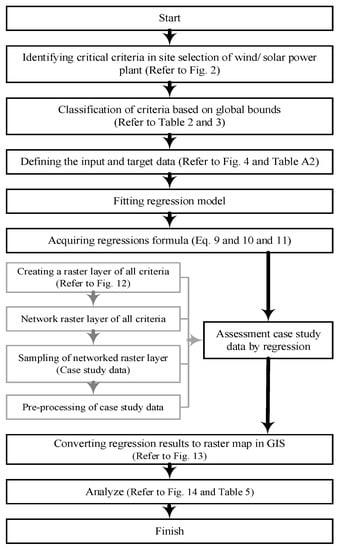
Figure 1.
The framework of the wind/solar site selection.
- Technical: wind-power density (WPD) and solar irradiation.
- Economic: land slope, distance from power lines, and distance from road networks.
- Social/environmental: distance from urban areas and distance from protected areas.
WPD describes wind resources independent of the characteristics of wind turbines [77]. It has been documented that turbines in sites with a high wind-power density display maximum efficiency in the production of electrical energy [78]. Solar irradiation correlates with the amount of power produced in solar collectors or solar arrays. Further, the long distances between power plants and the power grids increase the power loss and cost; therefore, wind or solar farms should be located close to the power lines. The land slope is another prime criterion to be considered in the site-selection of wind/solar power plants [79,80].
The steep land slope limits and the availability of cranes and trucks could increase the construction costs [79]. Therefore, to reduce the construction cost of new access roads, the energy site needs to be as close as possible to the road network [79]. Distance from urban and protected areas is considered a social/environmental factor. The installation of wind turbines close to urban and conservation areas is prohibited because of the visual impact, noise pollution, and wildlife protection. Hence, to minimize the negative social impact of wind and solar farms, places far from urban areas are rated better. To reduce the environmental effect of wind and solar power plants and protect wildlife, at least 1200 m distance from protected areas, including national parks, bird preserves, and water bodies, is necessary [79].
Figure 2 shows the criteria employed for wind/solar site-selection in this paper. In particular, WPD, solar irradiation, land slope, distance from the power lines, distance from the road network, distance from urban areas, and distance from protected areas are indicated with v1, v2, v3, v4, v5, v6, respectively.
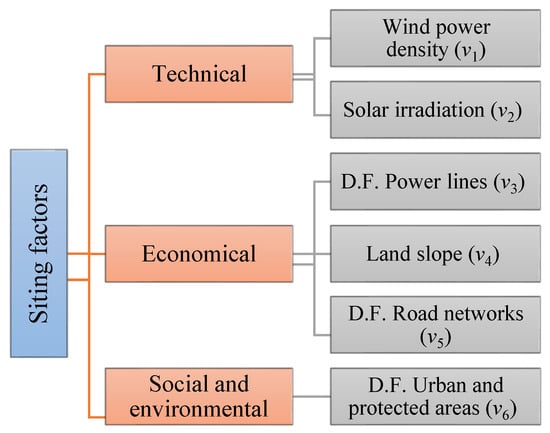
Figure 2.
Decision criteria considered in this paper (D.F.: distance from).
In addition to the effect of global and local wind regimes on wind energy, wind speed has a vertical profile that depends on the elevation from ground level, as follows [81]:
where and are wind speeds at heights and , respectively. stands for shear factor and depends on surface roughness [5]. Several studies have classified wind energy potential into seven classes based on its WPD at an elevation of 10 and 50 m above ground level [5]. This classification can be further extended to other elevations, as in Equation (5). Table 2 shows the classification of WPD at different elevations. The other criteria, including solar irradiation, land slope, distance from power lines, distance from road networks, distance from the urban areas, and distance from protected areas, can be classified according to the classes for power plant site selection (Table 3) [79].

Table 2.
Classification of wind-power density.

Table 3.
Classification of the other decision criteria.
Figure 3 presents the regression function that evaluates the suitability of a candidate location to construct a wind/solar power plant, considering the six criteria. The expression of this regression model is:
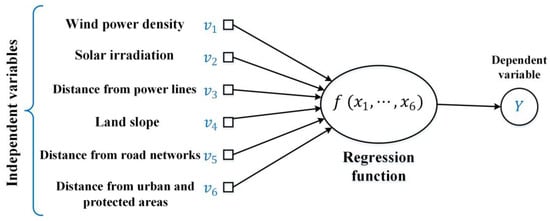
Figure 3.
Schematic representation of regression model to siting wind/solar farms.
Samples of data pairs (independent and dependent variables) are needed to obtain the regression function. To implement the regression function globally, the samples of dependent variables that span the entire criteria space are essential, i.e., all site specifications are considered in terms of the six criteria.
To obtain these data, the combination of the bounds used for the global criteria classes is used in this paper (Figure 4). The number of permutations equals , where 6 is the number of the site-selection criteria (the number of independent variables), and 8 is the number of bounds for criteria classes, respectively. The input data generated based on the permutations used to design the model are shown in Table A2.
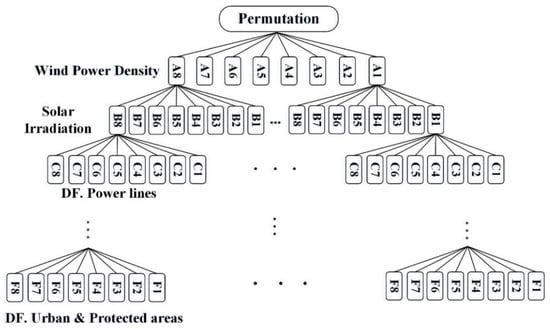
Figure 4.
Permutation of the bounds for the global classes of the criteria.
The dependent variable (site score) is obtained via a summation of weighted normalized bounds of the independent variables used for each permutation. In sum, each permutation represents one of the site positions for constructing a wind farm with six components. Each component represents a criterion in eight separate classes. Figure 5 illustrates the weighted normalized bounds of the criteria. This figure depicts the importance of each criterion in different classes to determine which criterion is more important to which class. In other words, it shows the contribution of each class of criteria to calculations of the site-selection score. The summation of the weighted normalized bounds for each permutation is expressed as the target data and is presented in Figure 5.
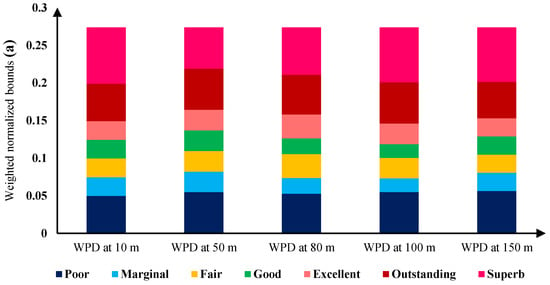
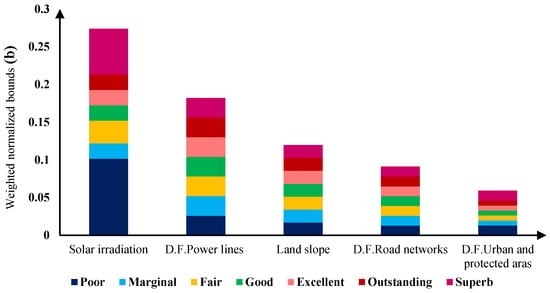
Figure 5.
Weighted normalized bounds of the criteria: (a) WPD at different elevations, (b) solar irradiation, land slope, and distance from power lines/road network/urban and protected areas.
However, AHP was used based on expert opinions to obtain the importance of the criteria. These opinions were applied as the judgment matrix in “Super Decisions” software to acquire the final criteria weight [82]. Figure 6 shows the general flowchart of the AHP; therefore, based on this figure, the first stage is goal determination in the decision-making process; the criteria and sub-criteria are specified in the following stages based on the determined goal. Then, a hierarchical structure is formed to obtain a judgment matrix. In the next steps, experts compare criteria and sub-criteria with each other in pairs based on the collected information. Finally, the judgment matrix is completed by comparing the criteria with each other. In the end, if the value of the consistency ratio (CR), which indicates the integrity of the experts’ decision, is less than 0.1, the judgment matrix is re-scored, but if it is more than one, the weight of the criteria is obtained. In this regard, Table A1 shows the judgment matrix and the consistency ratio in this article. Figure 7 defines the weights of the criteria obtained by AHP. Further descriptions are available in [83].
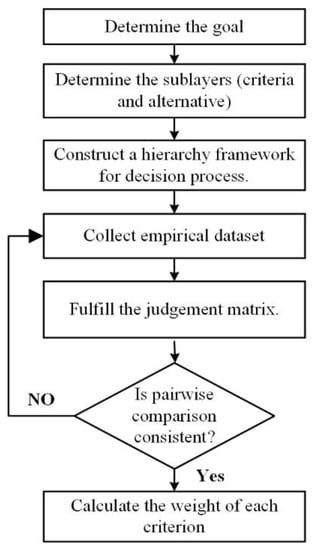
Figure 6.
Flow chart of the analytic hierarchy process (AHP).
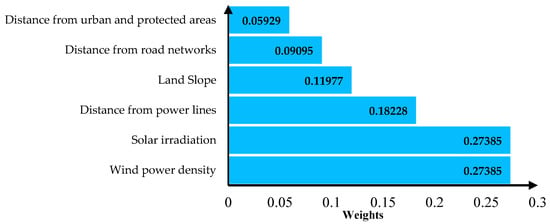
Figure 7.
Extracted weights by AHP for the six criteria used in this paper.
5. Designing the Regression Model
The potential map could be computed by linear regression using the sample pairs of dependent and independent variables. Since the WPD varies with altitude, a regression model is obtained in terms of height for the site-selection of wind/solar power plants, and can be derived as follows:
By comparing the regression models at five different heights, only the coefficient of WPD changes with varying altitudes. Therefore, a single formula is obtained by defining the coefficient β(h) as the WPD coefficient. Moreover, β calculated a function of height via polynomial interpolation (Figure 8), as follows:
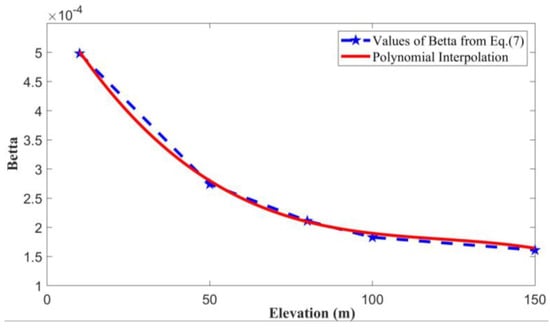
Figure 8.
Dependence of betta coefficient to elevation.
The final regression model used to calculate the wind/solar site score is defined in Equation (9):
In addition, site selection could be carried out solely for solar and wind farms using the regression function, irrespective of the WPD (v1) and solar irradiation (v2) coefficient, after the normalization of Equations (10) and (11):
Verification of the results was performed to assess the quality of the constructed model. First, an analysis of variance (ANOVA) can be used (Table 4), where ANOVA compares the variance among the group means and internal means of groups to reveal if they are part of another, more significant population [84]. A p-value of 0.05 or less is acceptable [85], and adjusted sums of squares (Adj S.S.) show the variations in different components of the model. In particular, adjusted mean squares (Adj MS) estimate how much variation an element or a model presents, irrespective of their order. Further, the adjusted mean squares consider the degrees of freedom (DF). DF is the amount of information in data [75,77], and the DF for an element of the model shows the amount of data used by a component. Figure 9 shows the predicted versus actual plot and perturbation plot, which verifies the high accuracy of the regression model. Figure 10 illustrates the regression performance as the surface plot, which shows the relation between the siting criteria of site selection and the site score.

Table 4.
Analysis of variance (ANOVA).
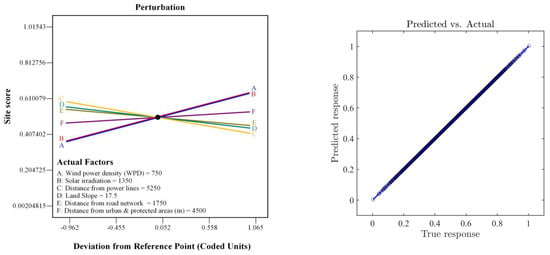
Figure 9.
Predicted versus actual plot and perturbation plot of site score.
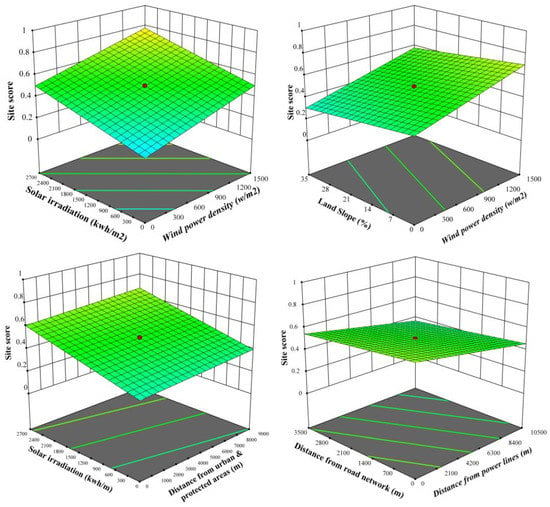
Figure 10.
The surface plot depicts the relationship between site-selection criteria and site score.
6. Results and Discussion
Case study 1: Varzeghan city, in East Azarbaijan province (Figure 11), has been studied using the proposed global regression model to select the most suitable site locations for the construction of wind, solar, and wind/solar farms. The city area is about 2350 km2. Figure 11 and Figure 12 show layers created by GIS to extract data for the six criteria required when calculating site scores for any candidate location. Here, each candidate location is supposed to be 100 m × 100 m in size. The sampled data of the layers are shown in Table A3.
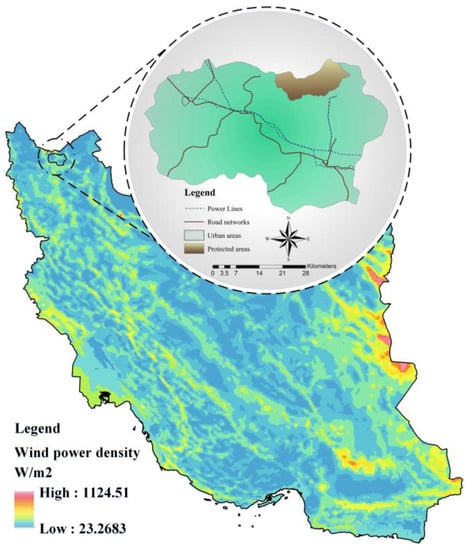
Figure 11.
Raster layer of wind power density (at 100 m elevation) and vector data for the study area.
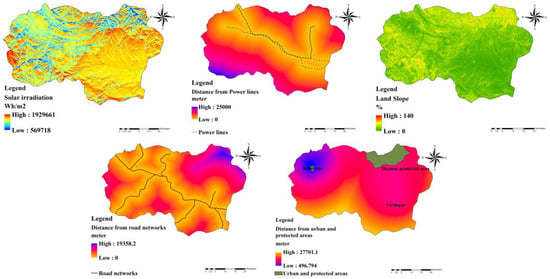
Figure 12.
Raster layers used for extraction of the criteria (in addition to the WPD raster layer of Figure 11).
Moreover, site scores obtained from the regression model are converted to a prioritization map of wind/solar power plants using GIS, as shown in Figure 13. Using Equations (10) and (11), it is possible to identify a suitable location to construct a wind or solar power plant.
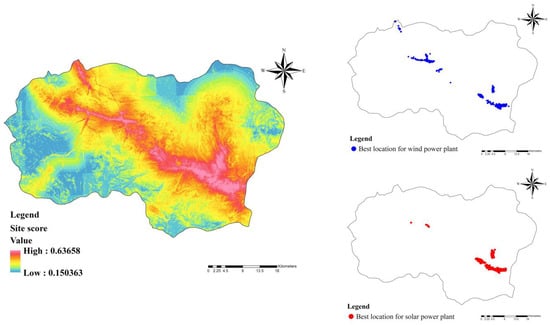
Figure 13.
Suitable area for wind/solar, wind, and solar farms.
Figure 13 also presents suitable locations for wind and solar farms individually. However, the best areas for wind, solar, and wind/solar power projects in the studied area are depicted in Figure 14. Table 5 outlines the characteristics of the highest score locations in the study area. Based on this table, the evidence shows that the locations suggested by the designed model for wind and solar power plants have high values for the six criteria.
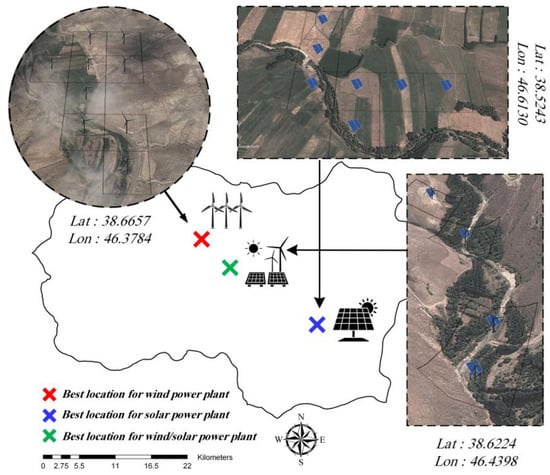
Figure 14.
The best locations for wind, solar, and wind/solar power projects in the study area.

Table 5.
Characteristics of the best locations for wind, solar, and wind/solar energy farms in case study 1.
Case study 2: Several existing wind, solar, and wind/solar farms worldwide have been evaluated using the regression function to present the global-scale site-selection ability of the model. The purpose of this analysis is to obtain site scores for large-scale renewable power plants. After calculating the scores of the world’s largest wind/solar power plants, the scores can be used as a pattern. In other words, the scores of these power plants form a suitable pattern for investors who want to construct renewable power plants in different locations. Therefore, this scoring pattern conveys in-depth knowledge to policy-makers to help them make decisions. The specifications of all fourteen sites are shown in Table 6, and their distribution across the world is shown in Figure 15. The power plants selected for scoring are mostly the largest renewable power plants in the world. According to Figure 15, these power plants have a diverse distribution on the surface of the earth. Seven out of fourteen locations are wind farms, six are solar power plants, and the remaining locations are hybrid wind and solar power plants. Further, the site scores were calculated and are presented in Figure 16 after extracting the decision criteria for the selected areas.

Table 6.
Specifications of the sites in case study 2.
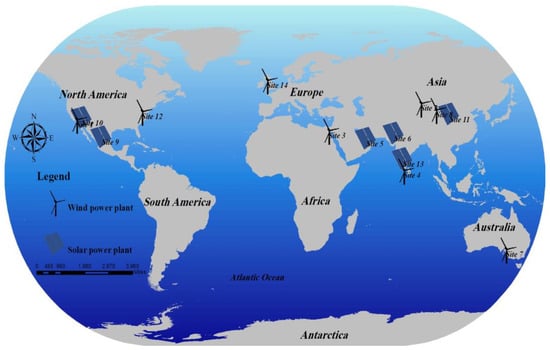
Figure 15.
Scattering of selected wind and solar power plants (14-cases) around the world (case study 2).

Figure 16.
Scores were derived for 14 studied site locations using the regression function.
The results show that the average scores for wind and solar and wind-solar power plants in large-scale power plants in the world are 0.7, 0.8, and 0.7, respectively.
According to Figure 15, the power plants in 14 sites are recommended in Table 7 for installation based on the type of power plant. As seen in Table 7, most of the installed power plants in case study 2 were adequately selected, while sites No. 3 and No. 8 could be considered exceptions. The first site is suited to solar or wind/solar energy farms, and the second site is appropriate for wind power plants. Overall, sites No. 1, 2, and 5 are the best locations for wind/solar, wind, and solar power plants, respectively, among the 14 site locations. Hence, it is proven that the developed model could be used to find the best location for solar, wind, and solar/wind sites.

Table 7.
Recommended power plants to be installed in the site locations of case study 2.
7. Conclusions
Solar and wind are two renewable sources of alternative energy that can avoid energy shortages and environmental pollution. However, these sources are not distributed equally on the surface of the earth. Therefore, it is essential to select an appropriate site location before designing and implementing wind, solar, and wind/solar power plants. This paper proposed a unique linear regression model to map decision criteria and site score and rank any site location based characteristic values (wind power density, solar irradiation, distance from power lines, land slope, distance from road networks, distance from urban and protected areas). To calculate the parameters of the regression function, global-scale data were used based on a global-scale classification of the criteria and permutation of these classes. Moreover, the analytical hierarchy process (AHP) was applied to extract the weights of each criterion. The calculated site scores varied between 0 and 1, from the global worst to the global best locations, respectively. Thus, the constructed regression function could estimate the suitability of any location for wind/solar, wind, and solar energy farms. To evaluate the performance of the constructed regression model, a northwestern county of Iran, Varzeqan, was studied, selecting the optimal locations for wind, solar, and wind/solar energy farms. The results of this study could be highlighted as follows:
- A total of 3.6% of the study area, with an area of 640 km2, was identified as a suitable location for the construction of wind farms, with 9 km2 considered as an ideal area. These areas scored an average of 0.6 in the proposed model, and were generally located north of the study area with an average wind-power density capacity of 2400 W/m2.
- A total of 3.8% of the study area, with an area of 620 km2, was identified as a suitable location for the construction of solar farms, with 7 km2 considered an ideal area. These areas scored an average of 0.83 in the proposed model, and were generally located southeast of the study area with an average solar irradiation of 1526 kWh/m2.
To demonstrate the easy application of this model, as well as accuracy of the obtained results, 14 existing wind, solar or wind/solar site locations worldwide were scored.
- Mohammed bin Rashid Al Maktoum’s solar power plant scored 0.92 using the proposed model, which was the highest score compared to other power plants, indicating that this is almost as close to an ideal solar power plant as possible from the model’s perspective.
- Among the wind power plants, Dabancheng wind power plants achieved the highest score of 0.82 among other power plants using the proposed model, and showed that power plants within this score range are of high quality.
In future work, outputs that are not subjective, such as power and cost, can be employed to design a model for power plant site selection. To achieve this purpose, the relationship between each of the site-selection criteria and the output of the model (cost or power) must be specified.
Author Contributions
Conceptualization, M.A.; Methodology, M.A.; Software, M.A.; Validation, M.A.; Formal analysis, M.A.; Investigation, M.A.; Resources, M.A.; Data curation, M.A.; Writing—original draft, M.A.; Writing—review & editing, K.P., Y.N., M.M. and G.I.; Visualization, M.M.; Supervision, K.P. All authors have read and agreed to the published version of the manuscript.
Funding
This research received no external funding.
Institutional Review Board Statement
Not applicable.
Informed Consent Statement
Not applicable.
Data Availability Statement
Not applicable.
Conflicts of Interest
The authors declare no conflict of interest.
Abbreviations
| Acronyms | |
| MODR | Multi-objective decision rules |
| GIS | Geographic information system |
| AHP | Analytic hierarchy process |
| ANP | Analytic network process |
| ELECTRE | ELimination Et Choix Traduisant la REalité |
| TOPSIS | Technique for Order of Preference by Similarity to Ideal Solution |
| VICORE | Viekriterijumsko kompromisno rangiranje |
| SAW | Simple additive weighting |
| RMSE | Root mean square error |
| D.F. | Degrees of freedom |
| ANOVA | Analysis of variance |
| MCDM | Multi-criteria decision making |
| TSS | Total sum of squares |
| PCA | Principal component analysis |
| RES | Renewable energy sources |
| SSE | Sum of squared errors |
| Nomenclature | |
| Dependent variable | |
| Predicted value | |
| Number of variables | |
| Regression coefficients | |
| Prediction error | |
| Rated speed of wind turbine (m/s) | |
| Independent variables | |
| Wind speed (m/s) | |
| Heigh (m) | |
| Number of observations | |
| WPD coefficient | |
| Subscript | |
| Wind-power density (W/m2) | |
| Solar irradiation (KWh/m2) | |
| Land slope (%) | |
| Distance from power lines (m) | |
| Distance from the road networks (m) | |
| Distance from urban and protected areas (m) |
Appendix A

Table A1.
The relative importance of AHP criteria and overall inconsistency.
Table A1.
The relative importance of AHP criteria and overall inconsistency.
| v1 | v2 | v3 | v4 | v5 | v6 | |
|---|---|---|---|---|---|---|
| v1 | 1 | 1 | 2 | 3 | 3 | 3 |
| v2 | 1 | 2 | 3 | 3 | 3 | |
| v3 | 1 | 2 | 3 | 3 | ||
| v4 | 1 | 3 | 3 | |||
| v5 | 1 | 3 | ||||
| v6 | 1 |

Table A2.
A little part of prepared train data based on permutation and AHP.
Table A2.
A little part of prepared train data based on permutation and AHP.
| j | Input Data | Target | |||||
|---|---|---|---|---|---|---|---|
| WPD 50 M | GHI | D.F.Powerline | Slope | D.F.Roads | D.F.Cities | ||
| 1 | 0 | 0 | 10,500 | 35 | 3500 | 2000 | 0.0000 |
| 2 | 0 | 0 | 10,500 | 35 | 3500 | 3000 | 0.0132 |
| 3 | 0 | 0 | 10,500 | 35 | 3500 | 4000 | 0.0198 |
| 4 | 0 | 0 | 10,500 | 35 | 3500 | 5000 | 0.0264 |
| 5 | 0 | 0 | 10,500 | 35 | 3500 | 6000 | 0.0329 |
| 6 | 0 | 0 | 10,500 | 35 | 3500 | 7000 | 0.0395 |
| 7 | 0 | 0 | 10,500 | 35 | 3500 | 8000 | 0.0461 |
| 8 | 0 | 0 | 10,500 | 35 | 3500 | 9000 | 0.0593 |
| 262,137 | 1000 | 2700 | 0 | 0 | 0 | 2000 | 0.9407 |
| 262,138 | 1000 | 2700 | 0 | 0 | 0 | 3000 | 0.9539 |
| 262,139 | 1000 | 2700 | 0 | 0 | 0 | 4000 | 0.9605 |
| 262,140 | 1000 | 2700 | 0 | 0 | 0 | 5000 | 0.9671 |
| 262,141 | 1000 | 2700 | 0 | 0 | 0 | 6000 | 0.9736 |
| 262,142 | 1000 | 2700 | 0 | 0 | 0 | 7000 | 0.9802 |
| 262,143 | 1000 | 2700 | 0 | 0 | 0 | 8000 | 0.9868 |
| 262,144 | 1000 | 2700 | 0 | 0 | 0 | 9000 | 1.0000 |

Table A3.
Samples of 100 m × 100 m resolution for the studied area after pre-processing.
Table A3.
Samples of 100 m × 100 m resolution for the studied area after pre-processing.
| Sample Number | v1 (W/m2) | v2 (kWh/m2) | v3 (m) | v4 (%) | v5 (m) | v6 (m) |
|---|---|---|---|---|---|---|
| 1 | 198.057 | 1169 | 10,500 | 35 | 3500 | 9000 |
| 2 | 198.990 | 9548 | 10,500 | 35 | 3500 | 9000 |
| 3 | 199.048 | 1242 | 10,500 | 35 | 3500 | 9000 |
| 4 | 198.600 | 1581 | 10,500 | 22.53 | 3500 | 9000 |
| ⋮ | ⋮ | ⋮ | ⋮ | ⋮ | ⋮ | ⋮ |
| 121,500 | 187.988 | 1096 | 10,500 | 35 | 3500 | 9000 |
| 121,501 | 187.845 | 995 | 10,500 | 35 | 3500 | 9000 |
| 121,502 | 187.809 | 887 | 10,500 | 35 | 3500 | 9000 |
| ⋮ | ⋮ | ⋮ | ⋮ | ⋮ | ⋮ | ⋮ |
| 234,862 | 358.131 | 915 | 1033 | 35 | 153 | 7176 |
| 234,863 | 356.878 | 900 | 1119 | 35 | 227 | 7229 |
| 234,864 | 290.036 | 995 | 1218 | 35 | 302 | 7280 |
References
- Jamshidi, S.; Pourhossein, K.; Asadi, M. Size Estimation of Wind/Solar Hybrid Renewable Energy Systems without Detailed Wind and Irradiation Data: A Feasibility Study. Energy Convers. Manag. 2021, 234, 113905. [Google Scholar] [CrossRef]
- Asadi, M.; Pourhossein, K. Wind Farm Site Selection Considering Turbulence Intensity. Energy 2021, 236, 121480. [Google Scholar] [CrossRef]
- Kannan, D.; Moazzeni, S.; Darmian, S.M.; Afrasiabi, A. A Hybrid Approach Based on MCDM Methods and Monte Carlo Simulation for Sustainable Evaluation of Potential Solar Sites in East of Iran. J. Clean. Prod. 2021, 279, 122368. [Google Scholar] [CrossRef]
- Abd El Aziz, Y. Renewables 2022 Global Status Report Germany Factsheet. 2022. Available online: https://www.ren21.net/wp-content/uploads/2019/05/GSR2022_Full_Report.pdf (accessed on 4 May 2023).
- Asadi, M.; Pourhossein, K.; Mohammadi-Ivatloo, B. GIS-Assisted Modeling of Wind Farm Site Selection Based on Support Vector Regression. J. Clean. Prod. 2023, 390, 135993. [Google Scholar] [CrossRef]
- Li, Z.; Tian, G.; El-Shafay, A.S. Statistical-Analytical Study on World Development Trend in Offshore Wind Energy Production Capacity Focusing on Great Britain with the Aim of MCDA Based Offshore Wind Farm Siting. J. Clean. Prod. 2022, 363, 132326. [Google Scholar] [CrossRef]
- Famoso, F.; Brusca, S.; D’Urso, D.; Galvagno, A.; Chiacchio, F. A Novel Hybrid Model for the Estimation of Energy Conversion in a Wind Farm Combining Wake Effects and Stochastic Dependability. Appl. Energy 2020, 280, 115967. [Google Scholar] [CrossRef]
- Deveci, M.; Cali, U.; Pamucar, D. Evaluation of Criteria for Site Selection of Solar Photovoltaic (PV) Projects Using Fuzzy Logarithmic Additive Estimation of Weight Coefficients. Energy Rep. 2021, 7, 8805–8824. [Google Scholar] [CrossRef]
- Tahri, M.; Hakdaoui, M.; Maanan, M. The Evaluation of Solar Farm Locations Applying Geographic Information System and Multi-Criteria Decision-Making Methods: Case Study in Southern Morocco. Renew. Sustain. Energy Rev. 2015, 51, 1354–1362. [Google Scholar] [CrossRef]
- Asadi, M.; Pourhossein, K. Neural Network-Based Modelling of Wind/Solar Farm Siting: A Case Study of East-Azerbaijan. Int. J. Sustain. Energy 2021, 40, 616–637. [Google Scholar] [CrossRef]
- Lo, H.W.; Hsu, C.C.; Chen, B.C.; Liou, J.J.H. Building a Grey-Based Multi-Criteria Decision-Making Model for Offshore Wind Farm Site Selection. Sustain. Energy Technol. Assess. 2021, 43, 100935. [Google Scholar] [CrossRef]
- Pennell, W.T.; Barchet, W.R.; Elliott, D.L.; Wendell, L.L.; Hiester, T.R. Meteorological Aspects of Wind Energy: Assessing the Resource and Selecting the Sites. J. Wind Eng. Ind. Aerodyn. 1980, 5, 223–246. [Google Scholar] [CrossRef]
- Calzonetti, F.J.; Eckert, M.S. Finding a Place for Energy: Siting Coal Conversion Facilities; Resource Publications in Geography: Washington, DC, USA, 1981. [Google Scholar]
- Cirillo, R.R.; Wolsko, T.D.; Mueller, R.O.; Dauzvardis, P.A.; Senew, M.J.; Gamauf, K.; Seymour, D.A. Evaluation of Regional Trends in Power Plant Siting and Energy Transport; Argonne National Lab.: Argonne, IL, USA, 1977. [Google Scholar]
- Solomon, B.D.; Haynes, K.E. A Survey and Critique of Multiobjective Power Plant Siting Decision Rules. Socioecon Plan. Sci. 1984, 18, 71–79. [Google Scholar] [CrossRef]
- Bowen, W.M. Subjective Judgements and Data Envelopment Analysis in Site Selection. Comput. Env. Urban Syst 1990, 14, 133–144. [Google Scholar] [CrossRef]
- Church, R.L.; Bell, T.L.; Weaver, J. Multiobjective Power Plant Siting Models: Optimization, Heuristic Approaches and Generating Alternative Configurations. Part I. Chapter I–V. Draft Final Report; Tennessee University: Knoxville, TN, USA, 1983. [Google Scholar]
- Baban, S.M.J.; Parry, T. Developing and Applying a GIS-Assisted Approach to Locating Wind Farms in the UK. Renew. Energy 2001, 24, 59–71. [Google Scholar] [CrossRef]
- Chen, F.; Yang, Q.; Zheng, N.; Wang, Y.; Huang, J.; Xing, L.; Li, J.; Feng, S.; Chen, G.; Kleissl, J. Assessment of Concentrated Solar Power Generation Potential in China Based on Geographic Information System (GIS). Appl. Energy 2022, 315, 119045. [Google Scholar] [CrossRef]
- Gao, J.; Wang, Y.; Huang, N.; Wei, L.; Zhang, Z. Optimal Site Selection Study of Wind-Photovoltaic-Shared Energy Storage Power Stations Based on GIS and Multi-Criteria Decision Making: A Two-Stage Framework. Renew. Energy 2022, 201, 1139–1162. [Google Scholar] [CrossRef]
- Van Haaren, R.; Fthenakis, V. GIS-based wind farm site selection using spatial multi-criteria analysis (SMCA): Evaluating the case for New York State. Renew. Sustain. Energy Rev. 2011, 15, 3332–3340. [Google Scholar] [CrossRef]
- Cheng, C.; Gutierrez, N.P.; Blakers, A.; Stocks, M. GIS-Based Solar and Wind Resource Assessment and Least-Cost 100 % Renewable Electricity Modelling for Bolivia. Energy Sustain. Dev. 2022, 69, 134–149. [Google Scholar] [CrossRef]
- Bennui, A.; Rattanamanee, P.; Puetpaiboon, U.; Phukpattaranont, P.; Chetpattananondh, K. Site Selection for Large Wnd Turbine Using Gis. In Proceedings of the International Conference on Engineering and Environment-ICEE-2007, Coimbra, Portugal, 3–7 September 2007; pp. 90–112. [Google Scholar]
- Wang, C.N.; Dang, T.T.; Nguyen, N.A.T.; Wang, J.W. A Combined Data Envelopment Analysis (DEA) and Grey Based Multiple Criteria Decision Making (G-MCDM) for Solar PV Power Plants Site Selection: A Case Study in Vietnam. Energy Rep. 2022, 8, 1124–1142. [Google Scholar] [CrossRef]
- Loughney, S.; Wang, J.; Bashir, M.; Armin, M.; Yang, Y. Development and Application of a Multiple-Attribute Decision-Analysis Methodology for Site Selection of Floating Offshore Wind Farms on the UK Continental Shelf. Sustain. Energy Technol. Assess. 2021, 47, 101440. [Google Scholar] [CrossRef]
- Ayough, A.; Boshruei, S.; Khorshidvand, B. A New Interactive Method Based on Multi-Criteria Preference Degree Functions for Solar Power Plant Site Selection. Renew. Energy 2022, 195, 1165–1173. [Google Scholar] [CrossRef]
- Abdel-Basset, M.; Gamal, A.; Chakrabortty, R.K.; Ryan, M. A New Hybrid Multi-Criteria Decision-Making Approach for Location Selection of Sustainable Offshore Wind Energy Stations: A Case Study. J. Clean. Prod. 2021, 280, 124462. [Google Scholar] [CrossRef]
- Asadi, M.; Pourhossein, K. Wind and Solar Farms Site Selection Using Geographical Information System (GIS), Based on Multi Criteria Decision Making (MCDM) Methods: A Case-Study for East-Azerbaijan. In Proceedings of the 2019 Iranian Conference on Renewable Energy and Distributed Generation, ICREDG 2019, Tehran, Iran, 11–12 June 2019. [Google Scholar] [CrossRef]
- da Ponte, G.P.; Calili, R.F.; Souza, R.C. Energy Generation in Brazilian Isolated Systems: Challenges and Proposals for Increasing the Share of Renewables Based on a Multicriteria Analysis. Energy Sustain. Dev. 2021, 61, 74–88. [Google Scholar] [CrossRef]
- Genç, M.S.; Karipo˘ glu, F.; Koca, K.; Azgın, ¸S.T. Suitable site selection for offshore wind farms in Turkey’s seas: GIS-MCDM based approach. Earth Sci. Inform. 2022, 14, 1213–1225. [Google Scholar] [CrossRef]
- Janke, J.R. Multicriteria GIS Modeling of Wind and Solar Farms in Colorado. Renew. Energy 2010, 35, 2228–2234. [Google Scholar] [CrossRef]
- Tegou, L.I.; Polatidis, H.; Haralambopoulos, D.A. Environmental Management Framework for Wind Farm Siting: Methodology and Case Study. J. Env. Manag. 2010, 91, 2134–2147. [Google Scholar] [CrossRef]
- Alami Merrouni, A.; Elwali Elalaoui, F.; Ghennioui, A.; Mezrhab, A.; Mezrhab, A. A GIS-AHP Combination for the Sites Assessment of Large-Scale CSP Plants with Dry and Wet Cooling Systems. Case Study: Eastern Morocco. Sol. Energy 2018, 166, 2–12. [Google Scholar] [CrossRef]
- Nagababu, G.; Puppala, H.; Pritam, K.; Kantipudi, M.P. Two-Stage GIS-MCDM Based Algorithm to Identify Plausible Regions at Micro Level to Install Wind Farms: A Case Study of India. Energy 2022, 248, 123594. [Google Scholar] [CrossRef]
- Wu, Y.; He, F.; Zhou, J.; Wu, C.; Liu, F.; Tao, Y.; Xu, C. Optimal Site Selection for Distributed Wind Power Coupled Hydrogen Storage Project Using a Geographical Information System Based Multi-Criteria Decision-Making Approach: A Case in China. J. Clean. Prod. 2021, 299, 126905. [Google Scholar] [CrossRef]
- Seyed Alavi, S.M.; Maleki, A.; Khaleghi, A. Optimal Site Selection for Wind Power Plant Using Multi-Criteria Decision-Making Methods: A Case Study in Eastern Iran. Int. J. Low-Carbon Technol. 2022, 17, 1319–1337. [Google Scholar] [CrossRef]
- Jbaihi, O.; Ouchani, F.Z.; Alami Merrouni, A.; Cherkaoui, M.; Ghennioui, A.; Maaroufi, M. An AHP-GIS Based Site Suitability Analysis for Integrating Large-Scale Hybrid CSP+PV Plants in Morocco: An Approach to Address the Intermittency of Solar Energy. J. Clean. Prod. 2022, 369, 133250. [Google Scholar] [CrossRef]
- Günen, M.A. A Comprehensive Framework Based on GIS-AHP for the Installation of Solar PV Farms in Kahramanmaraş, Turkey. Renew. Energy 2021, 178, 212–225. [Google Scholar] [CrossRef]
- Jun, D.; Tian-Tian, F.; Yi-Sheng, Y.; Yu, M. Macro-Site Selection of Wind/Solar Hybrid Power Station Based on ELECTRE-II. Renew. Sustain. Energy Rev. 2014, 35, 194–204. [Google Scholar] [CrossRef]
- de Araújo Costa, I.P.; de Araújo Costa, A.P.; Sanseverino, A.M.; Gomes, C.F.S.; Dos Santos, M. Bibliometric Studies on Multi-Criteria Decision Analysis (MCDA) Methods Applied in Military Problems. Pesqui. Oper. 2022, 42, 249414. [Google Scholar] [CrossRef]
- Moreira, M.Â.L.; Gomes, C.F.S.; dos Santos, M.; da Silva Júnior, A.C.; de Araújo Costa, I.P. Sensitivity Analysis by the PROMETHEE-GAIA Method: Algorithms Evaluation for COVID-19 Prediction. Procedia Comput. Sci. 2021, 199, 431–438. [Google Scholar] [CrossRef] [PubMed]
- Shaheen, M.; Khan, M.Z. A Method of Data Mining for Selection of Site for Wind Turbines. Renew. Sustain. Energy Rev. 2016, 55, 1225–1233. [Google Scholar] [CrossRef]
- Asadi, M.; Pourhossein, K. Locating Renewable Energy Generators Using K-Nearest Neighbors (KNN) Algorithm. In Proceedings of the 2019 Iranian Conference on Renewable Energy & Distributed Generation (ICREDG), Tehran, Iran, 11–12 June 2019; pp. 1–6. [Google Scholar]
- Asadi, M. Robust Site Selection of Solar/Wind Farms Using Neural Networks and Analytic Hierarchy Process. In Proceedings of the 7th Iran Wind Energy Conference, IWEC 2021, Shahrood, Iran, 17–18 May 2021. [Google Scholar] [CrossRef]
- Asadi, M.; Pourhossein, K. Modeling and Siting of Wind Farms Using Support Vector Regression (SVR). In Proceedings of the 2019 International Aegean Conference on Electrical Machines and Power Electronics, ACEMP 2019 and 2019 International Conference on Optimization of Electrical and Electronic Equipment, OPTIM 2019, Istanbul, Turkey, 27–29 August 2019; pp. 511–516. [Google Scholar] [CrossRef]
- Fan, B. A Hybrid Spatial Data Clustering Method for Site Selection: The Data Driven Approach of GIS Mining. Expert Syst. Appl. 2009, 36, 3923–3936. [Google Scholar] [CrossRef]
- Liu, F.; Wang, X.; Sun, F.; Wang, H. Correct and Remap Solar Radiation and Photovoltaic Power in China Based on Machine Learning Models. Appl. Energy 2022, 312, 118775. [Google Scholar] [CrossRef]
- Yousefi, H.; Motlagh, S.G.; Montazeri, M. Multi-Criteria Decision-Making System for Wind Farm Site-Selection Using Geographic Information System (GIS): Case Study of Semnan Province, Iran. Sustainability 2022, 14, 7640. [Google Scholar] [CrossRef]
- Ayodele, T.R.; Ogunjuyigbe, A.S.O.; Odigie, O.; Munda, J.L. A Multi-Criteria GIS Based Model for Wind Farm Site Selection Using Interval Type-2 Fuzzy Analytic Hierarchy Process: The Case Study of Nigeria. Appl. Energy 2018, 228, 1853–1869. [Google Scholar] [CrossRef]
- Heo, J.; Moon, H.; Chang, S.; Han, S.; Lee, D.E. Case Study of Solar Photovoltaic Power-Plant Site Selection for Infrastructure Planning Using a BIM-GIS-Based Approach. Appl. Sci. 2021, 11, 8785. [Google Scholar] [CrossRef]
- Zahid, F.; Tahir, A.; Khan, H.U.; Naeem, M.A. Wind Farms Selection Using Geospatial Technologies and Energy Generation Capacity in Gwadar. Energy Rep. 2021, 7, 5857–5870. [Google Scholar] [CrossRef]
- Bandira, P.N.A.; Tan, M.L.; Teh, S.Y.; Samat, N.; Shaharudin, S.M.; Mahamud, M.A.; Tangang, F.; Juneng, L.; Chung, J.X.; Samsudin, M.S. Optimal Solar Farm Site Selection in the George Town Conurbation Using GIS-Based Multi-Criteria Decision Making (MCDM) and NASA POWER Data. Atmosphere 2022, 13, 2105. [Google Scholar] [CrossRef]
- Loukogeorgaki, E.; Vagiona, D.G.; Vasileiou, M. Site Selection of Hybrid Offshore Wind and Wave Energy Systems in Greece Incorporating Environmental Impact Assessment. Energies 2018, 11, 2095. [Google Scholar] [CrossRef]
- Tan, Q.; Wei, T.; Peng, W.; Yu, Z.; Wu, C. Comprehensive Evaluation Model of Wind Farm Site Selection Based on Ideal Matter Element and Grey Clustering. J. Clean. Prod. 2020, 272, 122658. [Google Scholar] [CrossRef]
- Li, M.; Xu, Y.; Guo, J.; Li, Y.; Li, W. Application of a GIS-Based Fuzzy Multi-Criteria Evaluation Approach for Wind Farm Site Selection in China. Energies 2020, 13, 2426. [Google Scholar] [CrossRef]
- Sotiropoulou, K.F.; Vavatsikos, A.P. Onshore Wind Farms GIS-Assisted Suitability Analysis Using PROMETHEE II. Energy Policy 2021, 158, 112531. [Google Scholar] [CrossRef]
- Wang, C.N.; Viet, V.T.H.; Ho, T.P.; Nguyen, V.T.; Husain, S.T. Optimal Site Selection for a Solar Power Plant in the Mekong Delta Region of Vietnam. Energies 2020, 13, 4066. [Google Scholar] [CrossRef]
- Wu, Y.; Chu, H.; Dong, H.; Xu, C.; Chen, W.; Wu, G. Optimal Site Selection of Rural Wind–Photovoltaic-Storage Station from a Sustainable Development Perspective. Energy Rep. 2022, 8, 8381–8395. [Google Scholar] [CrossRef]
- Abdelmassih, G.; Al-Numay, M.; Aroudi, A. El Map Optimization Fuzzy Logic Framework in Wind Turbine Site Selection with Application to the USA Wind Farms. Energies 2021, 14, 6127. [Google Scholar] [CrossRef]
- Shorabeh, S.N.; Firozjaei, H.K.; Firozjaei, M.K.; Jelokhani-Niaraki, M.; Homaee, M.; Nematollahi, O. The Site Selection of Wind Energy Power Plant Using GIS-Multi-Criteria Evaluation from Economic Perspectives. Renew. Sustain. Energy Rev. 2022, 168, 112778. [Google Scholar] [CrossRef]
- Shafiee, M. Wind Energy Development Site Selection Using an Integrated Fuzzy ANP-TOPSIS Decision Model. Energies 2022, 15, 4289. [Google Scholar] [CrossRef]
- Mohammadzadeh Bina, S.; Jalilinasrabady, S.; Fujii, H.; Farabi-Asl, H. A Comprehensive Approach for Wind Power Plant Potential Assessment, Application to Northwestern Iran. Energy 2018, 164, 344–358. [Google Scholar] [CrossRef]
- Tafula, J.E.; Justo, C.D.; Moura, P.; Mendes, J.; Soares, A. Multicriteria Decision-Making Approach for Optimum Site Selection for Off-Grid Solar Photovoltaic Microgrids in Mozambique. Energies 2023, 16, 2894. [Google Scholar] [CrossRef]
- Sánchez-Lozano, J.M.; García-Cascales, M.S.; Lamata, M.T. GIS-Based Onshore Wind Farm Site Selection Using Fuzzy Multi-Criteria Decision Making Methods. Evaluating the Case of Southeastern Spain. Appl. Energy 2016, 171, 86–102. [Google Scholar] [CrossRef]
- Vagiona, D.G.; Tzekakis, G.; Loukogeorgaki, E.; Karanikolas, N. Site Selection of Offshore Solar Farm Deployment in the Aegean Sea, Greece. J. Mar. Sci. Eng. 2022, 10, 224. [Google Scholar] [CrossRef]
- Ali, F.; Bennui, A.; Chowdhury, S.; Techato, K. Suitable Site Selection for Solar-Based Green Hydrogen in Southern Thailand Using GIS-MCDM Approach. Sustainability 2022, 14, 6597. [Google Scholar] [CrossRef]
- Huang, X.; Hayashi, K.; Fujii, M. Resources Time Footprint Analysis of Onshore Wind Turbines Combined with GIS-Based Site Selection: A Case Study in Fujian Province, China. Energy Sustain. Dev. 2023, 74, 102–114. [Google Scholar] [CrossRef]
- Aghaloo, K.; Ali, T.; Chiu, Y.R.; Sharifi, A. Optimal Site Selection for the Solar-Wind Hybrid Renewable Energy Systems in Bangladesh Using an Integrated GIS-Based BWM-Fuzzy Logic Method. Energy Convers. Manag. 2023, 283, 116899. [Google Scholar] [CrossRef]
- Rekik, S.; El Alimi, S. Optimal Wind-Solar Site Selection Using a GIS-AHP Based Approach: A Case of Tunisia. Energy Convers. Manag. X 2023, 18, 100355. [Google Scholar] [CrossRef]
- Di Grazia, S.; Tina, G.M. Optimal Site Selection for Floating Photovoltaic Systems Based on Geographic Information Systems (GIS) and Multi-Criteria Decision Analysis (MCDA): A Case Study. Int. J. Sustain. Energy 2023, 1–23. [Google Scholar] [CrossRef]
- Ramezanzade, M.; Saebi, J.; Karimi, H.; Mostafaeipour, A. A New Hybrid Decision-Making Framework to Rank Power Supply Systems for Government Organizations: A Real Case Study. Sustain. Energy Technol. Assess. 2020, 41, 100779. [Google Scholar] [CrossRef]
- Rediske, G.; Burin, H.P.; Rigo, P.D.; Rosa, C.B.; Michels, L.; Siluk, J.C.M. Wind Power Plant Site Selection: A Systematic Review. Renew. Sustain. Energy Rev. 2021, 148, 111293. [Google Scholar] [CrossRef]
- Mentis, D.; Welsch, M.; Fuso Nerini, F.; Broad, O.; Howells, M.; Bazilian, M.; Rogner, H. A GIS-Based Approach for Electrification Planning-A Case Study on Nigeria. Energy Sustain. Dev. 2015, 29, 142–150. [Google Scholar] [CrossRef]
- Asadi, M.; Ramezanzade, M.; Pourhossein, K. A Global Evaluation Model Applied to Wind Power Plant Site Selection. Appl. Energy 2023, 336, 120840. [Google Scholar] [CrossRef]
- Fumo, N.; Rafe Biswas, M.A. Regression Analysis for Prediction of Residential Energy Consumption. Renew. Sustain. Energy Rev. 2015, 47, 332–343. [Google Scholar] [CrossRef]
- Raillani, B.; Mezrhab, A.; Amraqui, S.; Moussaoui, M.A.; Mezrhab, A. Regression-Based Spatial GIS Analysis for an Accurate Assessment of Renewable Energy Potential. Energy Sustain. Dev. 2022, 69, 118–133. [Google Scholar] [CrossRef]
- Gunturu, U.B.; Schlosser, C.A. Characterization of Wind Power Resource in the United States. Atmos. Chem. Phys. 2012, 12, 9687–9702. [Google Scholar] [CrossRef]
- Saxena, B.K.; Rao, K.V.S. Estimation of Wind Power Density at a Wind Farm Site Located in Western Rajasthan Region of India. Procedia Technol. 2016, 24, 492–498. [Google Scholar] [CrossRef]
- Höfer, T.; Sunak, Y.; Siddique, H.; Madlener, R. Wind Farm Siting Using a Spatial Analytic Hierarchy Process Approach: A Case Study of the Städteregion Aachen. Appl. Energy 2016, 163, 222–243. [Google Scholar] [CrossRef]
- Moradi, S.; Yousefi, H.; Noorollahi, Y.; Rosso, D. Multi-Criteria Decision Support System for Wind Farm Site Selection and Sensitivity Analysis: Case Study of Alborz Province, Iran. Energy Strategy Rev. 2020, 29, 100478. [Google Scholar] [CrossRef]
- Canul-Reyes, D.A.; Rodríguez-Hernández, O.; Jarquin-Laguna, A. Potential Zones for Offshore Wind Power Development in the Gulf of Mexico Using Reanalyses Data and Capacity Factor Seasonal Analysis. Energy Sustain. Dev. 2022, 68, 211–219. [Google Scholar] [CrossRef]
- Amer, M.; Daim, T.U. Selection of Renewable Energy Technologies for a Developing County: A Case of Pakistan. Energy Sustain. Dev. 2011, 15, 420–435. [Google Scholar] [CrossRef]
- Saaty, T.L. Decision Making with Dependence and Feedback: The Analytic Network Process; RWS Publisher: London, UK, 1996; Volume 4922. [Google Scholar]
- Myers, R.H.; Montgomery, D.C.; Anderson-Cook, C.M. Response Surface Methodology: Process and Product Optimization Using Designed Experiments; John Wiley & Sons: Hoboken, NJ, USA, 2016; ISBN 1118916034. [Google Scholar]
- Hosseini, S.; Taghizadeh, M.; Eliassi, A. Optimization of Hydrothermal Synthesis of H-ZSM-5 Zeolite for Dehydration of Methanol to Dimethyl Ether Using Full Factorial Design. J. Nat. Gas Chem. 2012, 21, 344–351. [Google Scholar] [CrossRef]
Disclaimer/Publisher’s Note: The statements, opinions and data contained in all publications are solely those of the individual author(s) and contributor(s) and not of MDPI and/or the editor(s). MDPI and/or the editor(s) disclaim responsibility for any injury to people or property resulting from any ideas, methods, instructions or products referred to in the content. |
© 2023 by the authors. Licensee MDPI, Basel, Switzerland. This article is an open access article distributed under the terms and conditions of the Creative Commons Attribution (CC BY) license (https://creativecommons.org/licenses/by/4.0/).